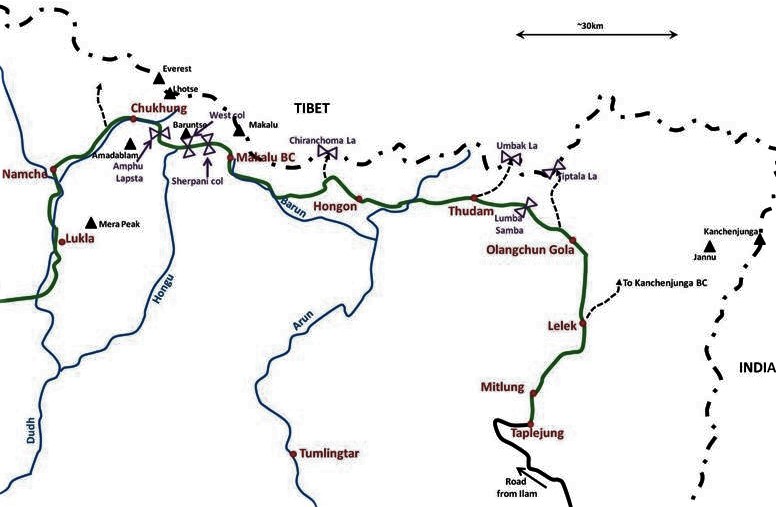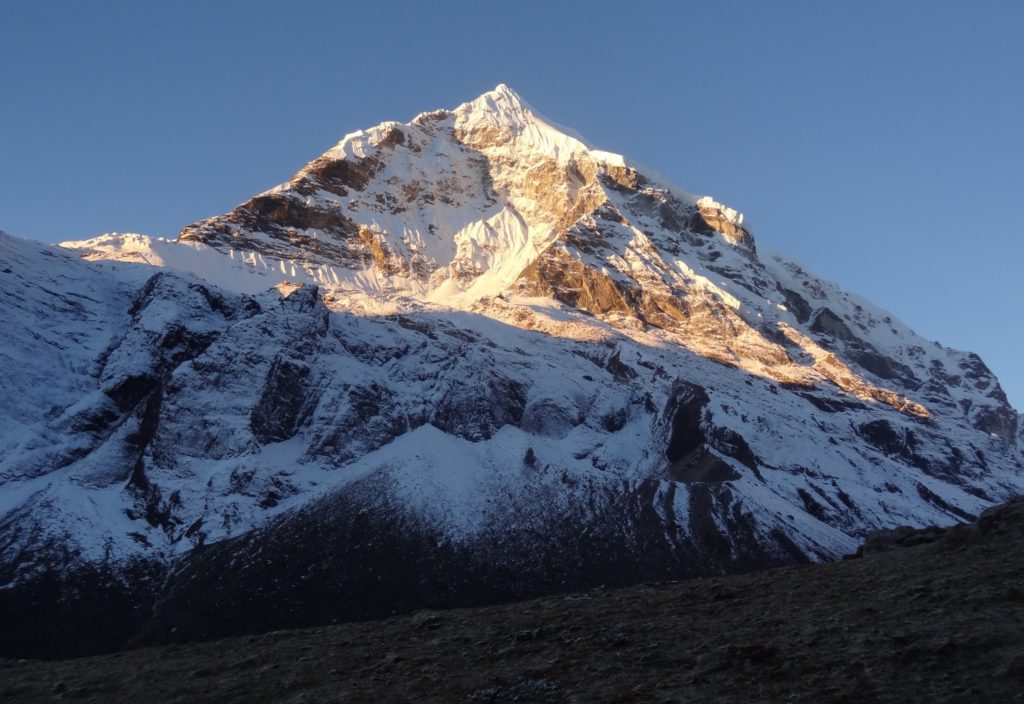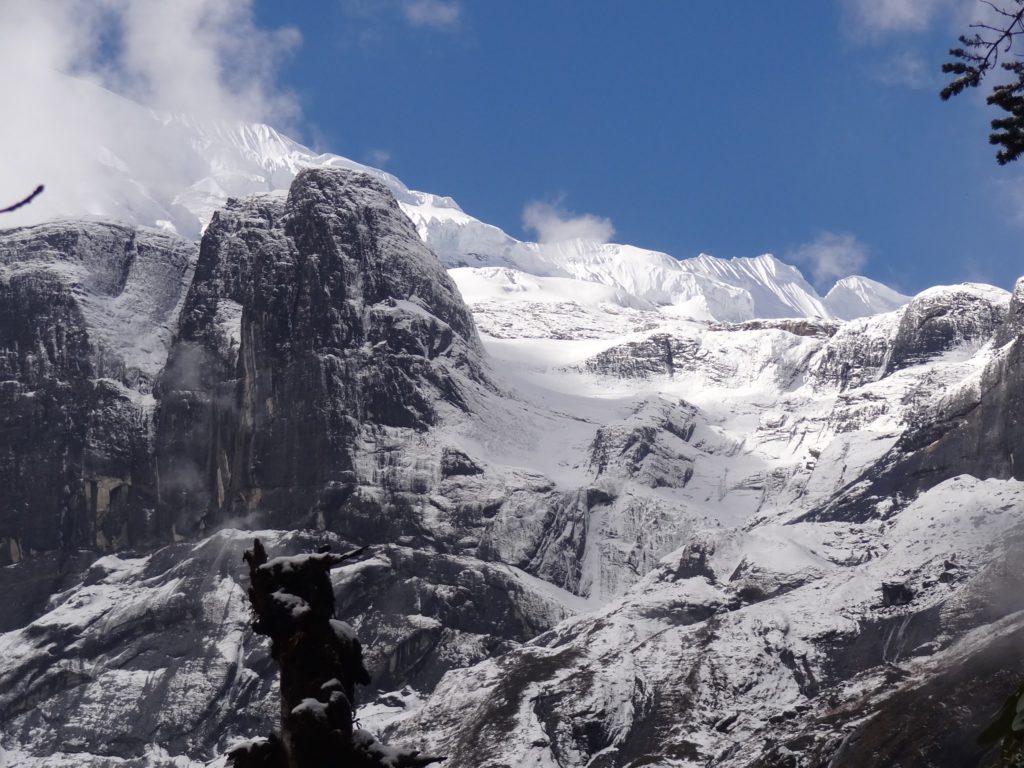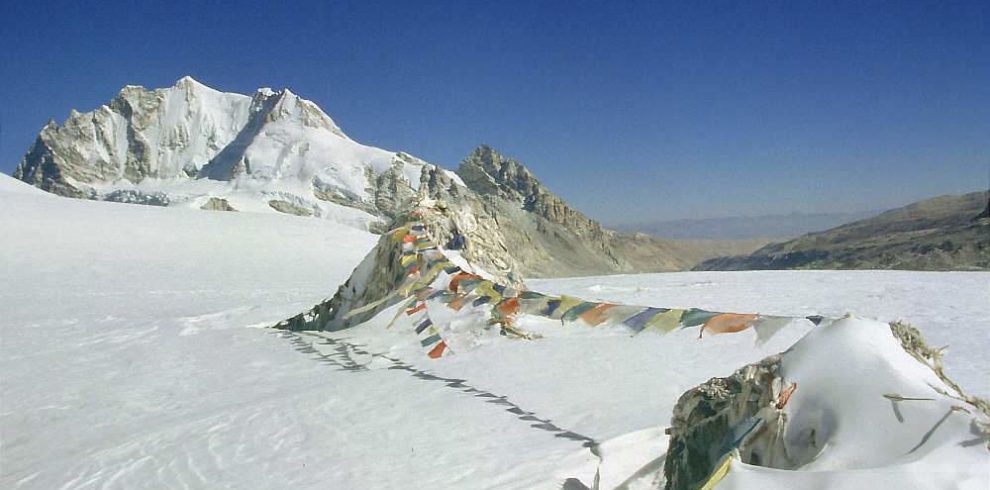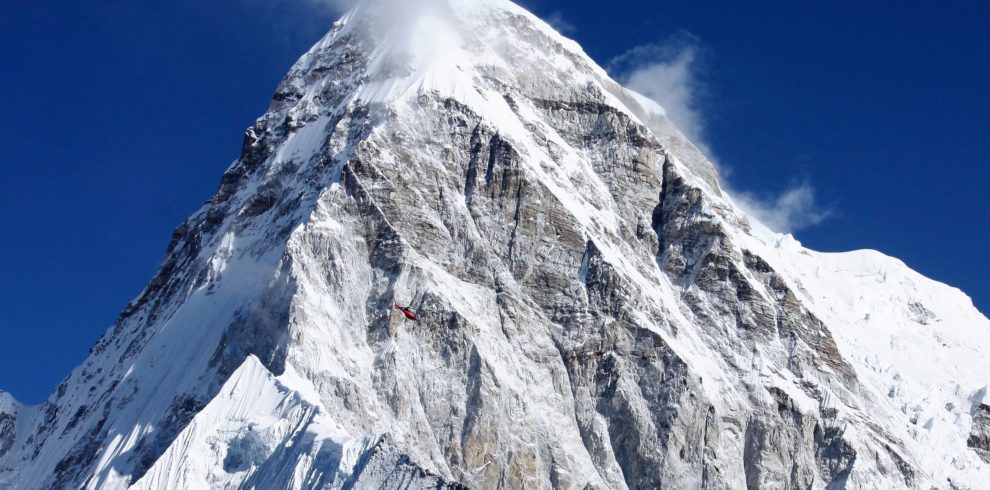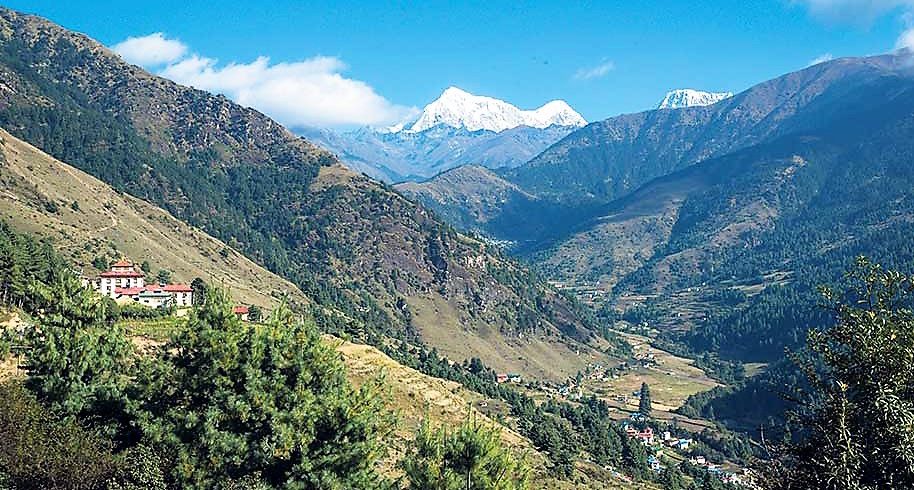Makalu Base Camp Trek is the fifth highest mountain in the world. This mountain situated in the Barun National Park. However, this high altitude trek grants us a panorama with typical mountains Nepali life. Such high hidden Trek permits us outstanding closeup scenery of many mountains. Moreover, the Picturesque of the highest mountain in the world such as Mt Everest, Mt Lhotse, and Mt Kanchenjunga. To crossing Shipton pass (4127 m), views of the south face of Makalu, as well as Everest and Lhotse are amazing. Also, we will have experience of Makalu Glacier Lake and Hungu valley. Trek demands a high level of physical fitness that is why this is a called challenging Himalayas trip. Even though the trek is famous for Tea house as a normal route nowadays.
The Makalu Circuit Trek begins with a 45min flight from Kathmandu to Tumlingtar. We can explore Base Camp envelops plain, sub-tropical. The exploration of the Himalayan lifestyle on a solitary trek is best for Makalu base camp (5250m). Mt. Makalu (8463 m) offers an extreme adventure for the mind soul.
Makalu Base Camp Trek Cost and Itinerary
Trek highlight heads up to the Arun river valley continue Sedua and Num villages. The itinerary follows the beautiful Barun river valley until the end. It takes you to high-altitude Tibetan terrains of Himalayas. Ultimately, base camp dispatch one of the most hidden and unfrequented areas of Nepal. Makalu base camp tea house trek is possible entirely but in the winter season, it may be closed. The Makalu valley is a part of a vast international protected area under the agreement between the governments of Nepal and China.
Trek lead into the basin to extraordinary temperate passes call Keke La pass (4230m) and Tutu La pass (4200m). Many edges ascend from the Barun River valley which is off the beaten mid-hill trails. Makalu base camp solo trek allowed because it is not in the restricted zone of Nepal. We have various clients Kanchenjunga Makalu trek review regarding this trip. This is not restricted trek so an individual is allowed to trek but the cost of accommodation and food is higher than expected. The normal Makalu trek permit is enough to operate the team.
Overview
Mt, Makalu is the fifth highest mountain in the world. The Makalu trek to base camp is a less-frequented route due to its relative inaccessibility and less popular. However, it’s not too hard to trek in the destination. As there are daily flights to Tumlingtar or a few hours’ drives from the trailhead and basic lodges along the way.
The Makalu Base Camp trek is an ideal trek for nature-loving. As the route ascends, you will pass through rhododendron forests, Deeper into the mountains. Past the Barun River Valley, you will pass steep granite cliffs, glaciers, and spectacular waterfalls of a hidden paradise. At the higher elevations, cover by Sherpa people, an ethnically Tibetan.
From Makalu Base Camp offers the spectacular views of the rarely seen Kangshung face of Everest. As well as Lhotse, Chamlang, and Kanchenjunga in the Far East. Well known hidden trek with beautiful wilderness walk. Trek has a variety of cultural and lively hood in the Makalu region People.
The early day we start tour Pashupatinath temple, Swayambhunath stupa and Bouddhanath stupa which are all world heritage sites. The Durbar Square sheds light on the life of the Gorkha royals in ancient times, which we can explore by some short of hiking, Pashupatinath temple is one of the most important places of pilgrimage for all Hindus religious. Swayambhunath is also known as the Monkey Temple and Boudhanath Stupa is one of the largest stupas in the world, where we can view most of the valley and surrounding mountains. At noon, we are introduced to our trekking guide team and discuss the trek in Everest hiker team. Overnight in Kathmandu.
Early morning, we took a flight to Tumlingtar is about 45 min. After breakfast and we will meet the rest of the trekking staff. Later we drive to Num village via Chichira, a small Gurung village. We take a rest at Chichira. Overnight in Num.
Included Meals: Breakfast Lunch Dinner
First few hours trek steep descent through forests and terraced farms until to Barun River. After crossing ascent up the other side again. The forest on the valleys offer a bit of shade but it will be hot due to a lower altitude. From Here Makalu Barun National Park begins and where we register our permits and team. We keep camp right at the top of the village. Overnight in Seduwa.
Included Meals: Breakfast Lunch Dinner
After breakfast trek keeps ascend the ridge bounded by the two rivers Ipsuwa and Kasuwa Khola. Crossing the hill through quiet villages and small paddy fields. We came to reach the exotic village of Tashi Gaon. From here, we will see breathtaking mountains panorama. Overnight in Tashigaon Village. Included meals: Breakfast Lunch Dinner
Today will be a bit of a tough day. As we have to walk on a steep trail in higher elevation up to 3500m. We keep ascend through forests to a stream and then onto a ridge. From here the trail gets steeper until passes a Kharka. And here we finally follow a series of rough stone stairs and small lakes ascending to the top of the ridge. Ultimately we descent down to Khongma Danda. Overnight in Khongma Danda.
Included Meals: Breakfast Lunch Dinner
Finally, we have the day off will allow some rest for a high pass. Before, we take on crossing of the Shipton La the flowing day. We can also explore the nearby surrounding area. Overnight at Khongma Danda. Included Meals: Breakfast Lunch Dinner
We prepare day to climb towards the summit of the Shipton La (pass). It takes a few hours to reach to the top. After reaching Lake Kalo Pokhari (3930m), towards pass over the Keke La at 4,170m. The view of marvelous Chamlang (7321m), Peak 6 (6,524m) and Peak 7 (6,758m). After crossing the Keke La pass, we descend towards to the beautiful valley to Mumbuk.
Overnight in Mumbuk
Included Meals: Breakfast Lunch Dinner
Day start inside the rhododendron forest which leads to the Barun River. We should be cautious the first two hours of the day as the way is steep. Finally, we took a pleasant path, slowly gaining altitude until we arrive at Yangri Kharka. Yangri Kharka situated at the base of the valley. Today the trek is quite a moderate walk to the valley. We pass through yak pastures, lush forests, and fields. We pass Merek hill as we make our way further up. Trek notice us a significant rise and scenic Himalayan. Overnight at Nehe Kharka.
Included Meals: Breakfast Lunch Dinner
Today is the big day we head towards the final Base Camp. From Langmale Kharka way goes up to Shershong and eventually to Makalu Base Camp. The trail to Makalu base camp is gently flat. View of Backdrop Mountains with icy glaciers and snow clad mountains. Mt Makalu comes into view as by the time approach Shershong. As we make our way to the Makalu camp, we will delight by mountains panorama. Overnight at Makalu Base Camp.
Included Meals: Breakfast Lunch Dinner
Big day at Base Camp. Makalu base is a rocky barren place with the massive Barun Glacier. From here we can view the magnificent south face of Makalu. And the complete panorama of Everest and Lhotse range. We can explore the surrounding lakes and glaciers around the valley. We hike up a bit more to accomplishment dream at the base camp itself. Overnight in Makalu Base Camp.
Included Meals: Breakfast Lunch Dinner
After accomplished our dream, we keep descend from the base camp and take our last glimpse of Makalu. We head down we pass Shershong, Langmale Kharka, and Merek. Finally, descend the valley for stopping at Yangri Kharka. Overnight in Yangri Khara.
Included Meals: Breakfast Lunch Dinner
From Yangri Kharka we keep descend through rock falls, and green forests. We had to follow the river banks of Barun. We descend the trail to reach Dobate. Overnight in Dobate.
Included Meals: Breakfast Lunch Dinner
We begin the trek with a steep climb from Dobate to Nambuk hill. And walk inside a forest of firs and rhododendron. Again cross the Keke La, Tutu La (Shipton’s Pass) and Kauma La in our massive day. Finally, within a few hours descend to Khongma Danda. Overnight at Khongma Danda. Included Meals: Breakfast Lunch Dinner
The trek continues same way that we did few days before with frequent long and steep descent cutting through the hillsides. Trek through thick forests and finally making it to the Sherpa village of Tashi village. Overnight at Tashigaon.
Included Meals: Breakfast Lunch Dinner
Today, we exit the Makalu Barun National Park and descend until Barun River. Then cross the hill and come across settlements. Finally, as we move further down stopping village at Seduwa. Overnight at Seduwa.
Included Meals: Breakfast Lunch Dinner
Again trek through lush forests towards Num. The trail goes up and down passes frequently through dense forests and Sherpa village. Overnight at Num village.
Included Meals: Breakfast Lunch Dinner
The final day of Makalu trip. We retrace our footsteps to Chichira. Last day to see the glorious vista of Mount Makalu. Overnight at Tumlingtar, ready for celebration with the crew. Ready to departure Kathmandu the following day. Overnight at Tumlingtar.
Included Meals: Breakfast Dinner
We fly back to Kathmandu after our long trek in the Hidden Valley. We can rest and relax throughout the day at the hotel. In the evening we celebrate our successful journey to the Makalu base camp with a farewell dinner. Overnight in town Kathmandu.
Included Meals: Breakfast Dinner
Cost Include
- Airport / pick up & transfer by car / Van.
- Domestic flight ticket KTM/Tumlingtar both way domestic airport tax
- 3 nights’ accommodation with breakfast at 3*** hotel in Kathmandu.
- Meals (breakfast, lunch, and dinner) with Tea & coffee and hot/cold water during the trek.
- Tea Lodge and Tented accommodation during the trek.
- All transportation by private transport.
- Makalu Barun National Park Permit and all necessary permits.
- All Camping Equipment’s (Tent, mattress, dining tent, kitchen tent, toilet tent, kitchen, etc.)
- Guide & support staff and their insurance and salary, foods, transport.
- The required number of local staff and porters to carry your luggage during the trek (We assign one porter for every two guests).
- Office Service charges and governments.
Cost doesn't include
- Any meals in Kathmandu Beside breakfast.
- Travel insurance (we would significantly be happy to assist).
- Both way International airfare
- Nepal Tourist Visa fee and more.
- Items and expenses of personal natures.
- Any kind of alcoholic drinks, cold drinks, laundry, phone calls, internet Etc.
- Personal Trekking Equipment’s like sleeping bags, jackets
- Emergency Evacuation (Helicopter Rescue).
- Any other costs whatsoever, that is not mentioned in the cost included.
- Tips for guide, porters, driver...
- Any costs which arise due to a change of the itinerary, due to landslides, political disturbance, and strikes, etc.
Check Gear list for Lumba Suma Pass Trek
In most of the causes before start our adventure, we’ll spend a day or part of a day doing some casual sightseeing in world heritage site valley surrounding before we leave for the trek, and we’ll check gear when you arrive if anyone needs for the trek. Please have photos, passport photocopy airline tickets to re-confirm and insurance information ready if needed. Let us detail.
Recommend Day-pack for Everest hiker
We recommend a 30-45 liter Day-pack for each in case of porter hiring. Better to have it too large than too small, as on pass days you’ll want to carry more when you need it. Most have internal water bladders built-in, which are good to have it for any situation. Make sure it’s comfortable before leaving home. Mines are 55 and 65 liters.
Generally, if you are going to hire porter in your daypack, you’ll be carrying 1 or 2 liters of water, a wind/Gortex/soft/ hard-shell jacket, wind/rain pants, hat & gloves, extra socks, sunscreen, snacks, water purifying tablets or filter, camera, a plastic bag or pack-cover and maybe a down jacket. Another remaining porter will assist you.
Packing/Storage
It’s easiest to pack and unpack from a duffel-bag, do for the most natural, porters to carry as well… Inexpensive and/or sound quality duffel are available in Kathmandu, but we can provide upon your request but it’s best to invest in a robust and waterproof duffel such as a North Face. You can leave/store extra gear in Kathmandu at our office storage room free of charge.
Extra Gear & Villagers
If anyone has old/extra/used gear of any sort, bring it along if you have room in your duffel you can donate it for porters and some orphans center or donation for villagers.
Our porters & staff also appreciate it can be old shirts, jackets, pants, fleeces, shoes to your old trekking socks. We often have a raffle on the first day of the trek, and each porter will get at least one ‘new’ thing, which is fun for them.
Recommend Snacks for Lumba Sumba Trek
It’s always good to have some snickers or bars at lower elevations. You crave terrific things at altitude, and often need energy in a way that you usually don’t at lower altitudes energy bars, electrolytes, etc are essential for long days or passes. Lemonade mix, Emergen-C, Tang, etc great to have for hot days in your water bottles can make huge differences. If anyone has a favorite cookie/biscuit, bring a package to share in the tent in the evenings with staff if you want. And anything else that you can bring particularly likes.
Water Purifiers & Filters
You can bring an MSR ceramic purifying/filtering pump along on the trek which everyone can use to pump freshwater in the evenings for the next day’s drinking water, ecologically the best way to get water in the Himalaya’s fragile trekking regions. Bring your pump, UV purifier or iodine tablets to have the capacity for fresh water whenever you want en route. Please bring at least unbreakable plastic/metal water bottles.
What we need for Everest trek
A copy of your travel medical insurance (just one sheet with policy number, name, and international contact numbers) as well as a password photocopy.
A copy of your Passport (front page) and Nepal visa
3 Visa-sized photo
Cash for Lumba Sumba trek
We run trek basis on beautiful during the trek for drinks, snacks, candy bars, biscuits, beer, etc. There’s some good shopping in Namche, sometimes a chance to buy locally made products. For tipping the crew we recommend about $100 per person in Nepali rupees or USD. There are ATMs in KTM which give you 350 USD, and many money changers, banks, etc available in Kathmandu and Lukla. In Namche, you can change TCs or cash, and some other places cash but we recommend you do it in Kathmandu. Guide also has extra rupees with them if anyone runs out and needs to borrow. For each Everest hiker, $250 is an excellent amount to change when you arrive in KTM.
Camera/ mobile Batteries recharge system
There are now many places to recharge batteries in the Everest, Annapurna, Manaslu and Langtang region so bring your camera battery chargers otherwise bring your solar panel. We recommend always bringing extra batteries as it takes time to charge and there is often a line in the busy time, charging is not always available and it can get expensive to charge your batteries up higher!
Washing & Showers in Lumba Sumba Trek
Showers are almost always available at the small lodges or our team crew will give you bucket hot shower. But they’re not cheap generally per head 3-5USD up to. So budget some extra cash if you like to shower daily! You can have (at no cost) a ‘warm washing bowl’ to wash up with. As for clothes, bring a small package of soap powder, and you can either wash your clothes yourself or laundry available in Namache our porters some money to wash them for you! That sometimes works.
Sleeping bag for Lumba Sumba Pass Trek
Down-filled sleeping bags rated to -10º are best because high altitude nights will be fresh for hikers but peak climber more than…Good down is fluffy, light and thick. A muff makes a big difference to the overall warmth of a bag and a mummy bag is generally warmer than a rectangular one. If your bag is rated for a higher temperature add a fleece sleeping bag liner to add warmth to the alpine zone.
Day-pack for Everest base camp trek
This should be comfortable in your choice, with a right waistband that transfers some of the weight to the hips. It needs to be big enough to take a jacket, fleece, drinking water, camera and odds and ends you might like during the day which should be always with you.
Duffel Bag for Makalu-Kanchenjunga trek
If you travel with porters, bring your gear in a duffel bag which helps to excess easy. Several companies make good duffel bags with a zipper along the side for ease of entry choose the best one. Get a bag that is durable and has a sturdy zipper some time it makes different. A duffel bag 40cm in diameter and about 80cm long is large enough to carry your gear and will usually meet the weight limit of porters and domestic flight rules.
Recommend Trekking Boots, for Makalu-Kanchenjunga trek
To finish happily trek you need comfortable feet. Quality boots have good ankle support, plenty of toe room for long descents, a stiff sole to lessen twisting torsion and are light, due to you don’t tire. Look at the inner lining – leather is good and Cambrelle is even better, a material that eats smelly foot bacteria and makes the extra relief. Good lightweight trekking boots or light all leather boots are ideal for a long day trek. Avoid arriving with brand new boots that you have not yet used before! Walk-in your new hiking boots on some steep hills and make it smooth that will test trouble spots before you leave home. The longer the trek, the better the boots you need, so took the best one for a happy journey.
Socks,
In the low country area, your feet will be warm or even hot while walking so quality cotton mix sports socks are excellent. Three to four pairs are enough for the trek. Thick trekking socks are better for higher up because you may walk in the snow, and evenings are cold where you can exchange. We suggest you bring four pairs or even 1 more. Mostly modern trekking boots fit snugly so wearing two pairs of socks at the same time is impractical to think twice.
Camp Shoes,
Luxury for your feet at the end of the day: sandals or running shoes is the best idea.
Fleece top,
Most trekkers consider this is essential, but alternatives are a thick thermal top or a light down jacket. In Kathmandu, you can get cheap Korean fleeces but they are not the best quality you needed.
Down Jacket or fiber-filled jacket,
Down clothing has the advantage of being light and compressible for alpine. A down jacket will stuff into a small space when packed, yet puff up. You should bring a good down jacket on all treks from your country or can buy in Kathmandu. Most ski jackets that have been used in your country are not warm enough and most so-called expedition parkas are too heavy and bulky. Don’t bring both a heavy and a light down Jacket; choose one that will serve both purposes, preferably ideal one with a hood that is also stuffed with down. If you feel extremely cold at high altitude, you will likely wear your down jacket inside your sleeping bag.
Wind or rain jacket
During the day trekking, you can use windproof, Waterproof and breathable. Plastic ponchos or non-breathable raincoats are not suitable for the trek.
Fleece/sweatpants,
Great for the chilly evenings, thicker is better and polypro is better than cotton in high.
Day-wear shirt,
T-shirts are favorite but a shirt with a collar and long sleeves are more practical during the day or in the evening. Regularly you can use two so you can swap damp for dry. Look one for shirts made of quick-dry fabrics rather than cotton.
Trekking pants,
You will live in these. Light material, loose-fitting, and dark-colored are best.
You can survive with only one pair but you have to bring two; get dusty or muddy so a change is a good idea. Cotton cheapies some marks in the local fashion, it is not necessary to have gore-tex or waterproof pants.
Neck gaiter,
For winter trekking they are the best for staying warm you need it, A fleece triangle with a Velcro fastening works well and is easy to pull up when the yaks stir up trail dust.
Trekking poles,
Useful, especially on steep, rough terrain, but if you are not used to using them you will not miss them someone who loves to do photography thinks twice.
Sunglasses,
Highly recommend good one suitable for snow, as it is bright up there, but specialized glacier glasses. Contact lens wearers report very few problems except cleaning them in the conditions it’s your matter. Ski goggles are unnecessary for trekking.
Mittens/Gloves,
These don’t need to be fancy (pockets are the warmest solution to cold hands), so local Kathmandu fleece gloves are excellent but you need it.
Water bottle,
Should be a one-liter size, except boiling water, and be leak-proof. You have to bring 2 or liter capacity in all. Sometimes mini Thomas a metal bottle can double as a hot water bottle on cold nights.
Torch,
LED bulbs are best for mountains. You will need a lamp for reading after dark, and for finding your way to the outhouses. A headlamp is excellent for climbing although many people prefer the second torch it’s enough.
Toiletries and odds and ends,
Bring essentials for the trek only otherwise you can buy in tea houses. There are a surprising number of showers or buckets of hot water available in the hotel. The smallest tube of toothpaste is perfect for a month in your favor. Roll-on deodorant can spare you grief with your tent partner toilet paper need. Hand cleaner in a bottle (“Parallel” or similar) is a good idea, it would be better for the environment than “handy wipes”.
Towel,
Bring only a small one for trekking, or consider using a sarong. Mountain shops sell towels made of a quick-dry fabric which is cost around 10USD. In Kathmandu, a city hotel does supply towels. Sunscreen and lip care with sun protection extremely needed during the day sun is intense at altitude, especially after snow, and you will want to use these most days.
Water purification,
One bottle of iodine tablets between two, Douglas or Potable Aqua is the best one. Shops in Canada sell Pristine, which is a good option. We tend to use boiled water from the lodges but occasionally we need to take water from the streams. The use of a mineral water bottle is discouraged from an environmental point of view and the higher it costs more.
Snow gaiters
These are not needed, but bring them if you already have some in case we get or cross a pass about 5400M high or you are coming in the winter season.
Evening camp wear,
Around the evening camp, you can wear camp shoes, lights sandals or leather boots. No matter what altitude and what season the temperature can get to -10º after dark. By far the best clothing is:
+ A down jacket, medium weight
+ Thick fleece pants
+ Fleece hat and neck gaiter
+ Thick shoes with wool socks
Available in Kathmandu or bring from home that we need.
1) Sleeping sheet
2) Duffel Bag
3) Trekking pants
4) Wind pants
5) Fleece top
6) Warm hat
7) Light gloves
8) Toilet paper
9) One litter of water bottle
10) Pee bottle
11) Lip care
12) Torch
13) Snow Gaiters
14) Water purification
Bring from home
1) Sleeping bag
2) Daypack
3) Trekking Boots
4) Running shoes
5) Socks
6) Camp shoes
7) Rain jacket
8) Nightwear top
9) Neck gaiter
10) Daywear shirt x2 or 3
11) Underwear
12) Sun hat
13) Sunscreen
14) Sunglasses
15) Toiletries and odds and ends
16) Small towel/sarong
17) Personal medicines
18) Camera
19) Money pouch/belt
20) Passport photos 2x
21) USD40 cash for a visa (30 days visa)
Makalu base camp
The Makalu base camp offers spectacular views of Mt. Makalu (8485m) and surrounding the fifth highest mountain in the world. Makalu Base Camp affords stunning views of the south face, with the south buttress of Makalu offering views of Everest and Lhotse and Baruntse (7220m). The Hillary and French base camps are far up the glacier
The approach to Makalu Base Camp has been compared to the Yosemite Valley trek. To reach some of the most amazing mountains scenery in the Himalaya. First, you have to cross the challenging Kongma Danda. There are few villages along with the approach to the hidden Makalu valley. Mt Makalu (8485m), summit, which stands 3km above Base Camp. Another famous difficult trekking route over the glaciated Sherpani Col (6180m), West Col (6190m) and Amphu Labsta (5845m). To been the Everest region involves the highest and hardest passes in the entire Himalaya in Nepal. However, the rewards of such an undertaking mountain scenery are more than worthwhile. During Makalu base camp trek there will be sections where the trail is very rugged or ill-defined. Space of some campsites will also be minimal. During the trek, may be necessary to make changes to the itinerary. At any time due to unforeseen circumstances such as adverse weather, snow or trail conditions. Your experiences trip leader will advise any changes should this occur.
Makalu Base Camp Trekking route lies in the area of Makalu Barun National Park in the heart of Eastern Nepal. This trek is Makalu Barun National Park in Solukhumbhu and Sankhuwasabha district. This Makalu National Park is established in 1992. Makalu trekking is formerly a restricted trekking area as a border Himalaya zone. Makalu trek extent five major ecological zones where the lush, tropical Arun Valley.
Here are details of Makalu Trek Highlights
See Everest from a unique angle, its eastern Kangshung face and more.
Gain views of eastern Nepal, as far away as Kangchenjunga and Makalu.
Pass from green terraced farmland to glaciers and waterfalls in Hidden Valley.
Witness the rural life of Nepal’s distinct Rai and Sherpa culture of Nepal.
Spot some of the rarest wildlife in Nepal, including the Red Panda, snow leopard.
Makalu base camp height is 4812m. Makalu Base Camp Trekking route lies in the area of Makalu Barun National Park in the heart of Eastern Nepal. This trek is Makalu Barun National Park in Solukhumbhu and Sankhuwasabha district. This Makalu National Park is established in 1992. Makalu trekking is formerly a restricted trekking area as a border Himalaya zone. Makalu trek extent five major ecological zones where the lush, tropical Arun Valley.
Yes, it would be possible to do a Teahouse. Makalu base camp tea house trek is possible entirely but in the winter season, it may be close.
Yes, it is possible to do Makalu base camp trek solo. Since it was not restricted trek for everyone it is not mandatory to hire guide and porter, But Shipton pass is always hard with full of snow, so it always better to hook guide for the trek. You can get permit and Tims in Kathmandu.
There are several packages available for Makalu base camp trek. However, we can do Makalu base camp trek tea house and also camping. Makalu tea house trek cost starts from 2000USD to 3400USD. there are various company and guide they can run a trip according to your plan.
Makalu base camp trek cost expensive because we have to booked flight both way from Kathmandu toTumlingtar. Also, trek considerably challenging to do for everyone tea house trek. because the Makalu base camp tea house trek is not well great it’s just necessary.
